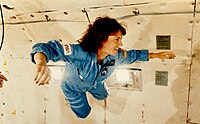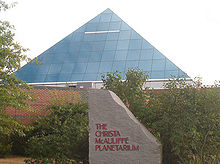Christa McAuliffe
From Wikipedia, the free encyclopedia
| Christa McAuliffe | |
|---|---|
 |
|
| NASA Spaceflight Participant[1] | |
| Nationality | American |
| Status | Killed during mission |
| Born | September 2, 1948 Boston, Massachusetts |
| Died | January 28, 1986 (aged 37) Cape Canaveral, Florida |
| Other names | Sharon Christa Corrigan |
| Other occupation | Teacher |
| Selection | 1985 Teacher in Space Project |
| Missions | STS-51-L |
| Mission insignia | |
| Awards | |
She received her bachelor's degree in education and history from Framingham State College in 1970, and also a Master of Arts in education supervision and administration[2] from Bowie State University in 1978. She took a teaching position as a social studies teacher at Concord High School in New Hampshire in 1983.
In 1985, McAuliffe was selected from more than 11,000 applicants to participate in the NASA Teacher in Space Project and was scheduled to become the first teacher in space.[3] As a member of mission STS-51-L, she was planning to conduct experiments and teach two lessons from Space Shuttle Challenger. On January 28, 1986, the spacecraft disintegrated 73 seconds after launch. After McAuliffe's death, schools and scholarships were named in her honor, and also in 2004 she was posthumously awarded the Congressional Space Medal of Honor.
Contents
Early life
McAuliffe was born Sharon Christa Corrigan on September 2, 1948, in Boston, Massachusetts. She was the eldest of the five children of accountant Edward Christopher Corrigan (1922–1990) of Irish descent[4] and Grace Mary Corrigan (née George), a substitute teacher,[5][6][7] whose father was of Lebanese Maronite descent.[4] McAuliffe was a great niece of Lebanese-American historian Philip Khuri Hitti.[8] She was known by the name "Christa" from an early age, although in later years she signed her name "S. Christa Corrigan", and eventually "S. Christa McAuliffe".[9]The year that McAuliffe was born, her father was completing his sophomore year at Boston College.[5] Not long thereafter, he took a job as an assistant comptroller in a Boston department store, and the family moved to Framingham, Massachusetts, where Christa attended and graduated from Marian High School in 1966.[10] As a youth, she was inspired by Project Mercury and the Apollo moon landing program. The day after John Glenn orbited the Earth in Friendship 7, she told a friend at Marian High: "Do you realize that someday people will be going to the Moon? Maybe even taking a bus, and I want to do that!"[11] She wrote years later on her NASA application form: "I watched the Space Age being born, and I would like to participate."[5][12]
Career as an educator
McAuliffe attended Framingham State College in her hometown, graduating in 1970 with a Bachelor of Arts in education and history.[13] A few weeks later, she married her longtime boyfriend who she had known from high school Steven J. McAuliffe, a 1970 graduate of the Virginia Military Institute, and they moved closer to Washington, D.C., so that Steven could attend the Georgetown University Law Center.[5][10] They had two children: Scott and Caroline, who were nine and six, respectively, when she died.[14]She was a social studies teacher, and taught several courses including American history, law, and economics, in addition to a self-designed course: "The American Woman".[17] Taking field trips and bringing in speakers were an important part of her teaching techniques. According to The New York Times, she "emphasized the impact of ordinary people on history, saying they were as important to the historical record as kings, politicians or generals."[18]
Teacher in Space Project
Main article: Teacher in Space Project
In 1984, President Ronald Reagan announced the Teacher in Space Project, and McAuliffe learned about NASA's efforts to find the first civilian, an educator, to fly into space.[19] NASA wanted to find an "ordinary person," a gifted teacher who could communicate with students while in orbit.[5][15] McAuliffe became one of more than 11,000 applicants.[19]
McAuliffe undergoing pre-flight training experiences weightlessness during a KC-135 "vomit comet" flight
| “ | I cannot join the space program and restart my life as an astronaut, but this opportunity to connect my abilities as an educator with my interests in history and space is a unique opportunity to fulfill my early fantasies. | ” |
|
—Christa McAuliffe, 1985[20]
|
||
The Council of Chief State School Officers, a non-profit organization of public officials in education, was chosen by NASA to coordinate the selection process.[25] Out of the initial applicant pool, 114 semi-finalists were nominated by state, territorial, and agency review panels. McAuliffe was one of two teachers nominated by the state of New Hampshire.[26] The semi-finalists gathered in Washington, DC, from June 22–27, 1985, for a conference on space education and to meet with the National Review Panel that would select the 10 finalists.[25]
On July 1, 1985, McAuliffe was announced as one of the 10 finalists, and on July 7 she traveled to Johnson Space Center for a week of thorough medical examinations and briefings about space flight.[25] The finalists were interviewed by an evaluation committee composed of senior NASA officials, and the committee made recommendations to NASA Administrator James M. Beggs for the primary and backup candidates for the Teacher in Space Project. On July 19, 1985, Vice President George H. W. Bush announced that McAuliffe had been selected for the position. Another teacher, Barbara Morgan, served as her backup.[27] According to Mark Travis of the Concord Monitor, it was McAuliffe's manner that set her apart from the other candidates.[26] NASA official Alan Ladwig said "she had an infectious enthusiasm", and NASA psychiatrist Terrence McGuire told New Woman magazine that "she was the most broad-based, best-balanced person of the 10."[26]
In the autumn of that year, McAuliffe and Morgan each took a year-long leave of absence from teaching in order to train for a space shuttle mission in early 1986.[5][28] (NASA paid both their salaries.) While not a member of the NASA Astronaut Corps, McAuliffe was to be part of the STS-51-L crew, and would conduct experiments and teach lessons from space. Her planned duties included basic science experiments in the fields of chromatography, hydroponics, magnetism, and Newton's laws.[29] She was also planning to conduct two 15-minute classes from space, including a tour of the spacecraft, called "The Ultimate Field Trip", and a lesson about the benefits of space travel, called "Where We've Been, Where We're Going, Why."[15][30] The lessons were to be broadcast to millions of schoolchildren via closed-circuit TV. To record her thoughts, McAuliffe intended to keep a personal journal like a "woman on the Conestoga wagons pioneering the West."[31]
After being chosen to be the first teacher in space, McAuliffe was a guest on several television programs, including Good Morning America; the CBS Morning News; the Today Show; and The Tonight Show Starring Johnny Carson, where, when asked about the mission, she stated, "If you’re offered a seat on a rocket ship, don’t ask what seat. Just get on."[32] She had an immediate rapport with the media, and the Teacher in Space Project received tremendously popular attention as a result.[5]
Disaster and aftermath
Main article: Space Shuttle Challenger disaster
The Presidential Commission on the Space Shuttle Challenger Accident—also known as the Rogers Commission—was formed to investigate the disaster. It determined that the accident was due to a failure of rubber O-rings made by Morton-Thiokol that provided a pressure seal in the aft field joint of the shuttle's right Solid Rocket Booster.[35] The failure of the O-rings was attributed to a design flaw, as their performance could be too easily compromised by factors that included the low temperature on the day of launch. The Commission found that O-ring resiliency is directly related to temperature and due to the low temperature at launch—36 degrees Fahrenheit or 15 degrees lower than the next coldest previous launch—it was probable the O-rings had not provided a proper seal.[35]
Barbara Morgan, McAuliffe's backup, became a professional astronaut in January 1998,[28] and flew on Space Shuttle mission STS-118, to the International Space Station, on August 8, 2007, aboard Endeavour, the orbiter that replaced Challenger.[28][36]
Legacy
Scholarships and other events have also been established in her memory. The Christa McAuliffe Technology Conference has been held in Nashua, New Hampshire, every year since 1986, and is devoted to the use of technology in all aspects of education.[46] The Nebraska McAuliffe Prize honors a Nebraska teacher each year for courage and excellence in education.[47] Grants in her name, honoring innovative teachers, are provided by the American Association of State Colleges and Universities and the National Council for the Social Studies.[48][49]
In 1990, McAuliffe was portrayed by Karen Allen in the TV movie Challenger.[50] The spaceship on the 1996–1997 children's science-fiction series Space Cases, about a group of students lost in space, was called "Christa".[51] In 2006, a documentary film about McAuliffe and Morgan called Christa McAuliffe: Reach for the Stars aired on CNN in the CNN Presents format.[52] The film, produced by Renee Sotile and Mary Jo Godges, commemorated the 20th anniversary of McAuliffe's death. The 75-minute feature version was narrated by Susan Sarandon, and included an original song by Carly Simon.[53]





No comments:
Post a Comment
Please leave a comment-- or suggestions, particularly of topics and places you'd like to see covered